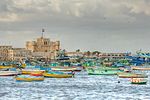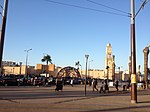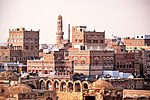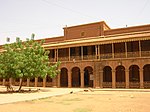List of largest cities in the Arab world
(Redirected from Largest Cities of the Arab League)
This is a list of largest cities in the Arab world. The Arab world is here defined as the 22 member states of the Arab League.[1]
Largest cities[edit]
Largest cities in the Arab world by official cities proper:[2][better source needed]
| Rank | Country | City | Population | Founding date | Image |
|---|---|---|---|---|---|
| 1 | Cairo | 22,623,874 | 
| ||
| 2 | Baghdad | 8,126,755 | 762 CE[4] | 
| |
| 3 | Riyadh | 7,820,551 | 1746 CE[5] | 
| |
| 4 | Alexandria | 5,696,131 | 332 BCE[6] | 
| |
| 5 | Amman | 4,642,000 | 7250 BCE[7] | 
| |
| 6 | Algiers | 4,515,000 | 944 CE[8] | 
| |
| 7 | Jeddah | 4,943,210 | 522 BCE[9] | 
| |
| 8 | Casablanca | 3,950,408 | 7th century[10] | 
| |
| 9 | Sana'a | 3,292,497[11] | ~500 BCE (possibly earlier)[12] | 
| |
| 10 | Dubai | 3,287,007 | 1833 CE[13] | 
| |
| 11 | Khartoum | 2,919,773 | 1824 CE[14] | 
| |
| 12 | Tunis | 2,800,000 | 814 BCE[15] | 
| |
| 13 | Abu Dhabi | 2,784,490 | 1761 CE[16] | 
| |
| 14 | Damascus | 2,685,000[17] | ~8,000–10,000 BCE (believed to be the oldest continuously inhabited city in the world)[18] | 
| |
| 15 | Beirut | 2,600,000 | ~3000 BCE (outer estimate)[19] | 
| |
| 15 | Kuwait City | 2,380,000 | 1613 CE[20] | 
| |
| 16 | Aleppo | 2,318,000 | ~5,000 BCE[21] | 
| |
| 18 | Irbid | 2,050,300 | ~3,200 BCE (possibly earlier) | 
| |
| 19 | Doha | 1,850,000 | 1823 CE[22] | 
| |
| 20 | Erbil | 1,750,564 | ~2300 BCE |  | |
| 21 | Mosul | 1,683,000 | ~700 BCE |  | |
| 22 | Muscat | 1,560,000 | 550 BCE | 
| |
| 23 | Hebron | 1,004,510 | 1727 BCE | 
|
See also[edit]
- List of largest metropolitan areas of the Middle East
- List of Arab countries by population
- List of largest cities in the Levant region by population
- List of largest cities
References[edit]
- ^ Frishkopf, Michael (2010). Music and media in the Arab world. The American University in Cairo Press. p. 61. ISBN 978-977-416-293-0.
- ^ "Demographia World Urban Areas" (PDF). Demographia. Retrieved 24 January 2019.
- ^ https://worldpopulationreview.com/world-cities/cairo-population
- ^ Corzine, Phyllis (2005). The Islamic Empire. Thomson Gale. pp. 68–69.
- ^ https://worldpopulationreview.com/world-cities/riyadh-population
- ^ Reimer, Michael (2016). "Alexandria". Encyclopedia Britannica.
- ^ https://worldpopulationreview.com/world-cities/alexandria-population
- ^ Chisholm, Hugh, ed. (1911). . Encyclopædia Britannica. Vol. 24 (11th ed.). Cambridge University Press. pp. 653–655.
- ^ https://worldpopulationreview.com/world-cities/jiddah-population
- ^ https://worldpopulationreview.com/world-cities/casablanca-population
- ^ "Sanaa Population 2023". worldpopulationreview.com. Retrieved 2023-08-14.
- ^ Chisholm, Hugh, ed. (1911). . Encyclopædia Britannica. Vol. 24 (11th ed.). Cambridge University Press. pp. 125–126.
- ^ "تاريخ دبي". حكومة دبي. Retrieved 9 April 2018.
- ^ Abdel Salam Sidahmed; Alsir Sidahmed (2004). "Chronology". Sudan. Routledge. ISBN 978-1-134-47947-4.
- ^ Serge Lancel (1995). Carthage. Translated by Antonia Nevill. Oxford: Blackwell. pp. 20–23.
- ^ Malcolm C. Peck (2007). "Chronology". Historical Dictionary of the Gulf Arab States. USA: Scarecrow Press. ISBN 978-0-8108-6416-0.
- ^ https://www.macrotrends.net/cities/22610/damascus/population=January 1, 2023.
{{cite web}}: External link in|author=|title=(help); Missing or empty|url=(help)CS1 maint: numeric names: authors list (link) - ^ UNESCO World Heritage Centre. "Ancient City of Damascus".
- ^ "Under Beirut's Rubble, Remnants of 5,000 Years of Civilization". New York Times. 23 February 1997. Retrieved 21 June 2023.
- ^ Al-Jassar, Mohammad Khalid A. (May 2009). Constancy and Change in Contemporary Kuwait City: The Socio-cultural Dimensions of the Kuwait Courtyard and Diwaniyya (PhD thesis). The University of Wisconsin-Milwaukee. p. 64. ISBN 978-1-109-22934-9.[permanent dead link]
- ^ [[1]], Sixth Edition (2010)
- ^ Dumper, Michael; Stanley, Bruce E.; Abu-Lughod, Janet L. (2007). Cities of the Middle East and North Africa: A Historical Encyclopedia. ABC-CLIO. ISBN 978-1-57607-919-5.
